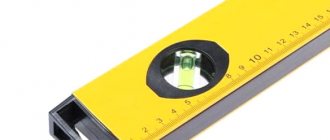The market for building materials for working with electrical communications, machinery and low-voltage equipment offers a wide range of tools. Let's look at what an indicator screwdriver is. Let's get acquainted with the design of various modifications and their functionality. After reading the article, it will be easier to make the best choice for solving certain problems in everyday life or during repairs.
A simple indicator screwdriver with a neon light Source allegroimg.com
Types of devices
The main structural elements of the tools are a narrow flat blade (“minus” screwdriver) and a light or sound indicator. The remaining parts serve as additional components. For example, the housing connects, hides and protects parts. Batteries provide the power necessary for the operation of the indication or electronic display. Let's take a closer look at the device, operating principle and how to use this or that tester screwdriver.
Components of a universal device Source instrumentgid.ru
Neon lamp probe
The design of such an indicator screwdriver is considered the simplest in its group. It is intended to solve only one problem - determining the presence or absence of voltage in the conductor. In this case, operation is possible only if the threshold of 60-70 Volts is exceeded. Rarely, screwdrivers are used for a 12-36 V network.
Structurally, the electrical probe consists of a metal tip and a body. Inside the handle there is a neon light bulb and a microcircuit with a transistor and a resistor. Additionally, a spring and a closing plate can be installed on the end of the handle.
The principle of operation of the device without a contact pad is simple. Here the indication is triggered after the tip touches a serviceable section of the low-voltage circuit. The plate in other probes serves to supply current to the light bulb. Here you just need to touch the sensor with your finger. It is safe for a person to be the contactor of the second contact of the indicator in the chain, since the resistor has a resistance value in the range of 0.5-1 MOhm.
Tester with batteries
This device is equipped with a field-effect or composite transistor (usually bipolar), LED indication, and a contact plate.
Tester with batteries Source amazon.com
The latter is needed to determine the functionality of the screwdriver. A person must touch the tip and the end of the handle, then the light will light up (if the tester is in good condition).
There is also a slot for placing 2-3 coin-type batteries. If the indication does not work during the test, then they need to be replaced. To do this, simply unscrew the end part of the handle.
The functionality of the LED device includes solving the following problems:
- Determination of phase. A similar action is typical for any type of indicator screwdriver. However, with a battery-powered sample, wires in an insulating winding can be examined with the same efficiency.
- Definition of zero. A simple probe does not distinguish an open circuit from a neutral conductor - the neon light does not light in both cases. A tester with batteries can replace a multimeter, as it is able to detect and show the integrity of the cable.
- Calling. This implies an inspection of fuses, heating elements, and incandescent lamps for integrity. It is also possible to detect a break in the winding of a transformer or other electrical device or equipment.
Checking an incandescent lamp Source yandex.net
- Breakdown check. This action applies to diodes, including searching for anodes with cathodes.
- Search for cable. This is especially true when repairing walls with hidden wiring. But a particular device has a limitation in the depth of the desired line. The indicator does not exceed 1.5 cm.
Inexpensive indicator screwdrivers for their cost allow you to solve quite a lot of problems. However, there is one important drawback - small batteries have a low charge. To prevent the batteries from running out longer, experts recommend that the protruding part of the tip be insulated during passive storage of the device. For example, you can take a PVC tube (cambric) of the required diameter and cut a cap of sufficient length from it.
See also: Catalog of companies that specialize in electrical work of any complexity
Non-contact device
The tester, similar to the previous version, runs on batteries. Only here batteries are used with higher power (for example, type 23A at 12 V). Also, a distinctive feature is not a metal tip, but a short plastic tip. The voltage indication is supplemented by an audible signal.
Contactless device Source 5×86.ru
Such electrical receivers are characterized by high sensitivity. There are samples on which adjustment is permissible in order to test the network with different voltages. Thanks to the built-in sensors, work can be performed without direct contact of the tip with the conductor or its insulation.
In addition to searching for wires connected to the network and determining voltage (or lack thereof), a non-contact screwdriver-voltage indicator can find hidden metal elements. This could be a disconnected cable or reinforcement in a reinforced concrete structure. Such an error is an unjustified addition. Therefore, it is better to entrust the search for wiring to other devices.
Universal device
The combined type of indicator screwdriver combines a light and sound indicator, a metal tip, and batteries. This also applies to the functional part. Here you can perform work using the contact method and without touching the conductor or its insulation. You can check the integrity and connection of the cable, determine polarity, look for breaks and short circuits in both direct and alternating current conditions.
Universal screwdriver-indicator Source zubr-vrn.ru
Electronic devices
Due to their wide functionality, such electrical probes are conventionally called a miniature version of a multimeter. But you should not rely on the device’s readings due to its low accuracy. The indication here can be LED (there are 2 or more of them, different colors) or the information is displayed on a liquid crystal display. The verification method is contact and non-contact.
Digital multimeters
Digital instruments that measure voltage - multimeters - are very popular among professionals. This universal device for an electrician allows you to check several characteristics of an electrical circuit at once: voltage, current, resistance. In addition to sound and light signaling elements, the device is equipped with a digital display.
Additionally, special current clamps can be purchased that allow you to measure current without damaging the wiring insulation. Some models are equipped with a temperature sensor to check the temperature of electrical equipment - distribution cabinets, switches, electric motors. Such devices, as a rule, are used by those specialists who, due to their line of work, have to visit substations with complex electrical equipment.
Criteria for selecting an electrical probe
Experts recommend equipping your home workshop (toolkit) with a simple contact screwdriver-indicator with an LED. This is enough to detect voltage or determine the integrity of the conductor, to find its location in the thickness of the wall. Samples with broad functionality are distinguished by more thorough instructions for the user, which requires constant practice to memorize.
The main selection criteria look like this:
- Voltage . For a single-phase network, the limit values can be 70-250 or 100-250 V, for a three-phase network - up to 400 V. If you have to work with a low-voltage network, then 12-24-36 V are considered.
Tester for working with networks up to 250 V Source zubr-vrn.ru
- Tip length . The size can be 12 or 18-19 mm. That is, it is either easier to work in hard-to-reach places (oven) or when the research object is located at a distance (wire, contacts).
Before paying, it is important to check the device for serviceability. You also need to find out the type of batteries used; it is better to purchase spare ones in advance. Among other things, you need to find out in advance how to use a particular indicator screwdriver.
Where can I buy
To purchase a screwdriver as quickly as possible, you can visit your nearest specialty store. The optimal option, in terms of price-quality ratio, remains purchasing from the AliExpress online store. Mandatory long waits for parcels from China are a thing of the past, because now many goods are in intermediate warehouses in destination countries: for example, when ordering, you can select the “Delivery from the Russian Federation” option:
| 3 in 1 Digital Multimeter Voltage Indicator Tester Voltmeter | Screwdriver with voltage tester | Indicator screwdriver NAVIGATOR 155941 |
| Multi-digit test pencil AC DC 12-250V | Voltage indicator 100-220 V | ANENG Digital Indicator Screwdriver with LCD Display, 12-250V |
Rules for using testers
It is permissible to work only with a working tool. This doesn't just apply to batteries. It is important that there is no damage to the case. For safe use, experts recommend discarding the insulating tape and replacing the screwdriver with a new one.
As for the network, it needs to be de-energized. Even after a power outage, exposed areas of wiring can only be touched with a testing tool. Moisture in any form must be excluded to eliminate the risk of electric shock.
Checking the network with the machines turned off Source brigadir-info.ru
When checking the electrical wiring, do not touch the metal tip. A voltage with parameters that are characteristic of the network under study passes through it. The body of the pen is made of plastic that can protect a person from electric shock. Otherwise, the manufacturer writes in the instructions how to use the indicator screwdriver. Let's take a closer look at these recommendations.
Checking the serviceability of the tool
In addition to identifying external damage, you need to know how to check the indicator screwdriver for functionality. To do this, just insert the tip into each socket of a known working socket. A working device turns on the indication during contact with the phase.
How to operate different devices
A simple device needs to be applied with a tip to one of the conductors. If there is a contact plate, then you need to touch it with your finger. This is where the work ends, there are no other instructions.
How to use an indicator screwdriver with an LED - the rules are similar to the simplest tool for a contact sample. Only the contact plate is touched to check the serviceability of the tool.
Checking the indicator screwdriver for functionality Source eltctricon.ru
Non-contact testers do not provide for closing the internal circuit. Here the indication is triggered at a distance from the network if there is voltage in a specific area. However, the diode can also light up at an open circuit, which is important to consider during testing. But you can work with low-voltage systems.
Universal testers are a little more complicated. There is a contact plate and a light indication that works when the internal circuit is closed. In addition, there may be a built-in toggle switch for setting one or another operating mode. The marking implies the following:
- O. _ Network testing is performed using the principle of a simple screwdriver with a contact pad.
- L. _ The operating principle is identical to a contactless battery-powered device.
- H. _ High sensitivity mode. You can work with a low response threshold, which helps detect hidden wiring.
Device with a toggle switch for setting the operating mode Source yandex.net
Rules for using voltage indicators
When working with this kind of tool, there are a number of rules that you need to know in order to do everything correctly.
Here you need to adhere to the following recommendations:
- compliance with the rules of safe work with electrical networks. This means that all manipulations with the indicator screwdriver should be carried out with the package switches turned off;
Switches turned off in the electrical panel.
- remember that electric current always flows through a conductor along the path of least resistance (from plus to minus);
Note! Any electrical appliance will function only if its phase/plus goes through the circuit to the neutral/negative wire of the network.
- Such an indicator meter of any type is not suitable for assessing complex electrical appliances. With its help, you can check the serviceability of electrical circuits of devices;
- in houses and apartments there is a standard network with a purity of 50Hz and a voltage of 220V;
- When working with such a screwdriver, you need to know that the (+) phase always receives voltage, the zero leads to the transformer (-), and the third wire is grounding (for example, in a socket).
When using a signal screwdriver in various works, be sure to adhere to the above rules. Otherwise, you may get the completely opposite result.
Briefly about the main thing
An indicator screwdriver is a device for detecting voltage in the network.
Depending on the modifications of the probes, you can additionally search for wires in walls, determine polarity, and detect open circuits or short circuits.
There are contact and non-contact devices, with neon or diode indication. There are samples with sensitivity settings and a digital display.
The user instructions include a preliminary check of the serviceability of the tool and how to operate a specific model.
Scope of application of indicator screwdrivers
The voltage indicator is used for the following purposes:
- Determination of phase, neutral wire;
- Determining the polarity of rechargeable batteries and batteries;
- Search for hidden (immured) wiring in the wall;
- Search for an open circuit;
- Checking the performance of heating elements, incandescent lamps, diodes and other radio components.
In addition, using digital models of modern devices, you can determine the voltage value and the location of the positive and negative electrodes on the diode.
Checking different devices
Contact method
In order to find out the integrity of the internal circuit of the electric lamp, you must:
- Place the indicator probe on the input contact of the lamp.
- Place your finger on the contact plate of the screwdriver.
- With your other hand, grasp the lamp base in order to close the circuit between your hands.
- If the device lights up, then the lamp is working.
The tester allows you to easily check the open circuit and the operating condition of the electric heating element for the presence of a breakdown in the body. In both cases, a universal or LED device is required.
Breakdown test:
- In order to identify the contact of the device with the body of current-carrying elements, it is necessary to take it in your hand - it is a source of electrical charge.
- With your other hand, you need to take the tester so that one finger is located on the contact plate, and in turn apply the probe to the terminals of the heating element.
- During a breakdown, the circuit will close and the device will light up (show the phase) - the heating element must be changed.
Finding the switch position
All switches in the house by default must be in such a position that to turn on you need to press the top of the key, and to turn off you need to press the bottom. Because of this, during installation, a situation arises when the key must be turned over after installation due to the fact that its lower part closes the circuit. Using a screwdriver-tester, having “ringed” the circuit in advance, this problem can be avoided.
Non-contact method
After installing a chandelier with several lamps, it becomes necessary to determine the correct connection. Using a universal tester, this is very easy to do - you need to switch the device to the required mode (H or L) and bring it to the switched off chandelier.
If after this a sound signal sounds and the corresponding light comes on, then there is an electric field near the lamp, and accordingly, the wires are connected to the common phase wire incorrectly. If everything is done in compliance with safety requirements, the indicator will only work when the light is turned on.
Determination of the break area
When powering electrical appliances using an extension cord, a situation arises when a break in the network is obvious, but it is not known exactly where it is located. If the socket is in working condition, then you need to check the extension cable and the device for a break. To do this, you need to plug in the device and run the tester along the entire length of the circuit in mode L. A break has occurred in the area where the device does not respond to the presence of an electric field.
If no fault is found throughout, then it is necessary to repeat the procedure by turning the plug in the switch so that the current flows through the other cable core. If in this case a break is not found, then the problem must be looked for directly in the tool.











